
Introduction
We are still here.
Please email: global_support@kerridgecs.com
if you have any queries regarding our software.
The latest versions list of our software can be viewed
here
In the mid 1970s, Alex d'Agapeyeff who worked at CAP Ltd
(Computer Analysts and Programmers) recognised the potential of microprocessors and the newly developed microcomputers. He created BOS (Business Operating System).
His father was Alexander d'Agapeyeff (1902-1955) of Codes and Ciphers fame.
Picture of Alex d'Agapeyeff taken in June 2002 here
(Alex on left). Taken from Cap
News
Sadly, Alex passed away on 26th March 2003.
In 1976, CAP Microsoft was formed to market services based on BOS and MicroCobol. Source
The Business Operating System, or BOS is an early cross-platform operating system originally produced for Intel 8080 and Motorola 6800 computers, subsequently for Z80-based computers, and then later for most microcomputers of the 1980s. CAP Ltd, a British company and at the time one of the world's largest Information Technology consulting firms, developed BOS. CAP designed BOS and BOS applications for platform-independence.
BOS was spun off to three interlinked companies, MPSL (MicroProducts Software Ltd) which looked after the sales and marketing of BOS, MPPL (MicroProducts Programming Ltd) which looked after both the development of BOS and various horizontal software package and MicroProducts Training Ltd. BOS was distributed on a global basis, mainly to the US and British Commonwealth by a variety of independent and MPSL owned companies.
A small dealer/ distributor network along with its command line nature was its demise when graphical user interface operating systems became prevalent.
MPSL developed numerous products for BOS, generally targeting the horizontal markets, leaving the vertical markets (i.e. niche) to independent software vendors. Examples of MPSL developed software include BOS/Finder (database), BOS/Planner (spreadsheet), BOS/Writer (word processor) and BOS/AutoClerk (report generation). Companies sold various BOS accounting software suites in the UK, Australia, New Zealand, South Africa and the USA. In the UK, BOS accounting packages were considered to be the industry standard by most accountants.
BOS applications were compiled to a p-code and interpreted as they ran. BOS had a p-code interpreter so efficient that programs, even the BOS/Writer word processor, ran sufficiently fast to satisfy users. Apart from a 2-kilobyte (Kb) server (computing)/host kernel, BOS is written in BOS/MicroCobol, a language based on COBOL but with system level programming constructs added and elements of structured programming, which bore a vague similarity to Pascal. In recent computing, programming languages such as Java have re-introduced the concept of p-code “virtual machines”.
BOS required 48 Kb of RAM and two 250 Kb floppies, though it was more commonly deployed on machines equipped with 64 kilobytes of RAM and a hard drive. A computer with 128 KB RAM and a 10-megabyte (Mb) hard drive could run as many as five concurrent users. When the IBM PC XT came out in 1983, BOS served over eight concurrent dumb terminals on it. At the time, this made BOS very attractive.
With user-management tools and application programming interfaces, BOS was considered an alternative even to the platform-specific operating systems on machines such as the PDP-11 and the Vax.
Despite, or because of its command line interface, BOS remains popular with small, medium and large organisations in the UK & beyond.
History

In the mid 1970s, the CAP Ltd computer services group formed a specialist division to develop software products that would exploit the power of the newly-invented microprocessors. The initiative was part-funded by the UK government, for which CAP was a leading software supplier and which wished to encourage an indigenous software industry. CAP staff list 1980
By 1981 the Microproducts division had developed a uniquely portable operating system (BOS), a programming development environment (BOS/MicroCobol) and a complete suite of business applications - accounting ledgers, including Payroll, stock control, order processing and invoicing modules, and office automation tools (word processor, database, spreadsheet).
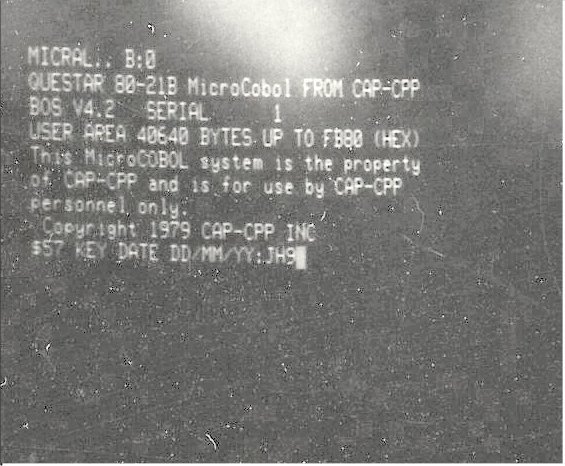
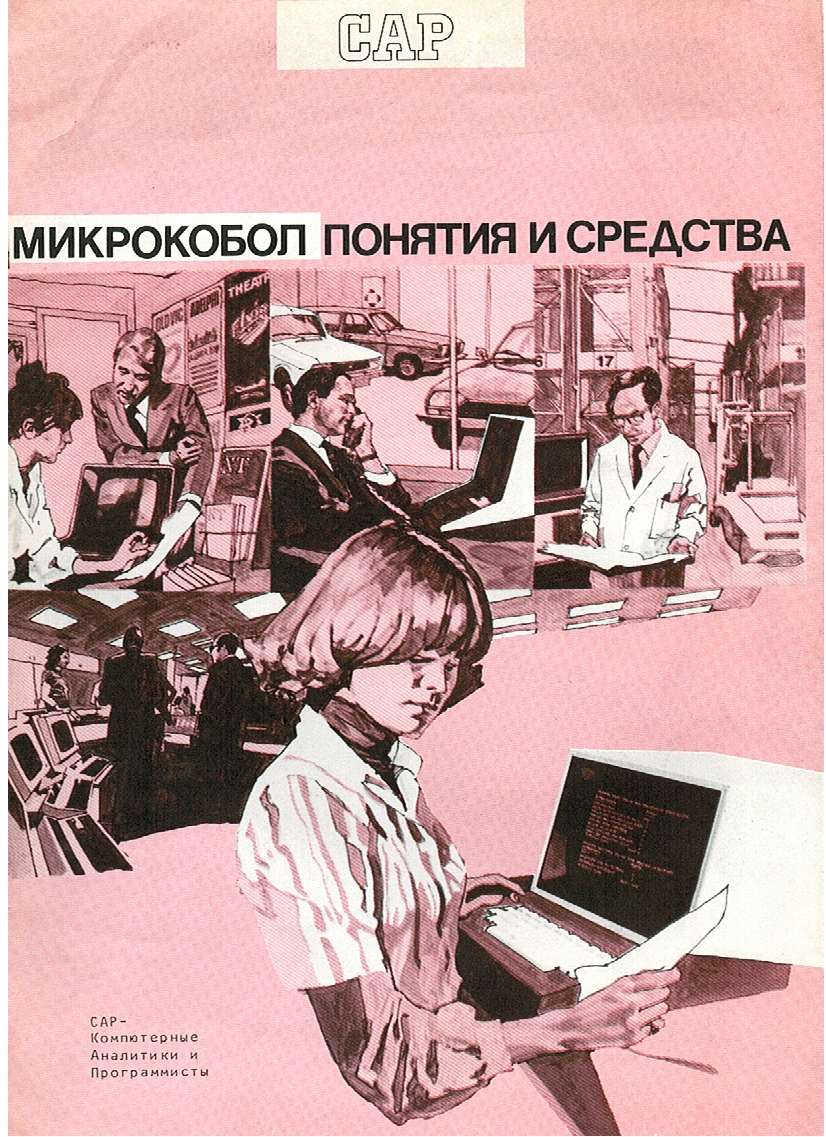 |
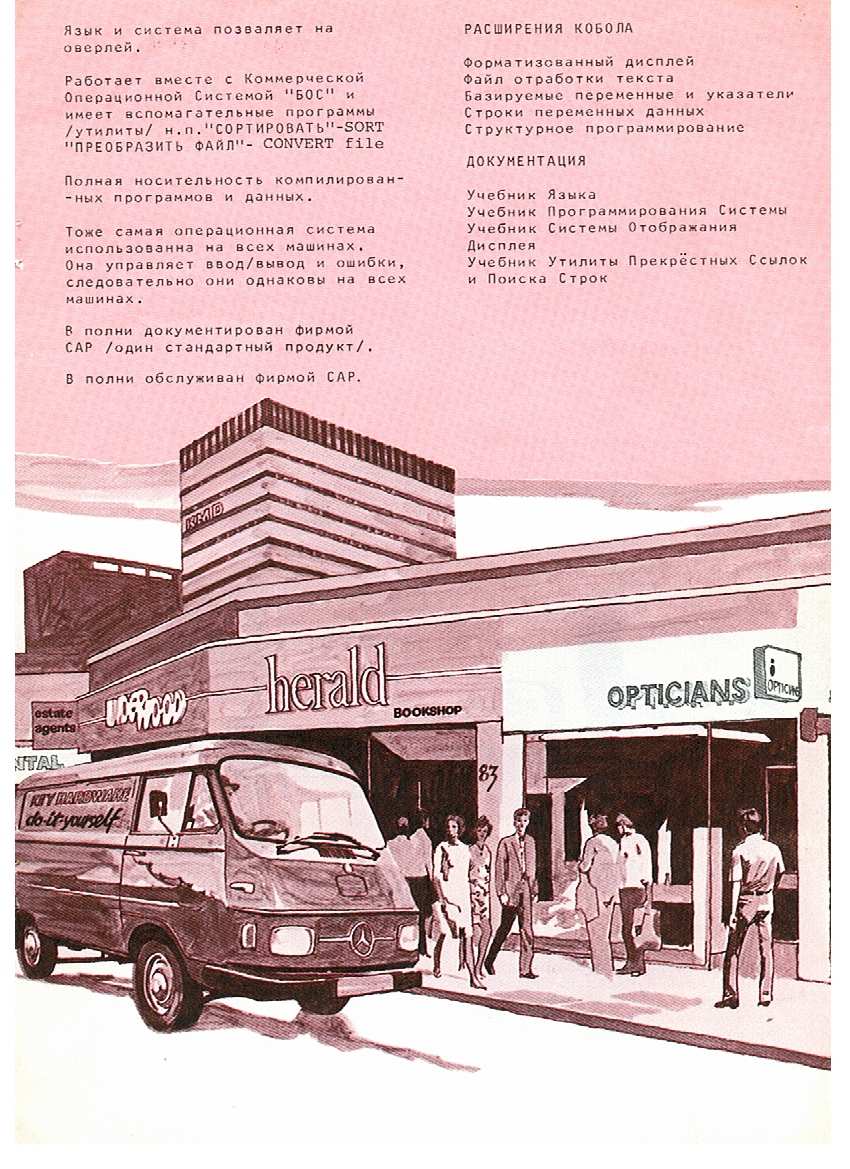 |
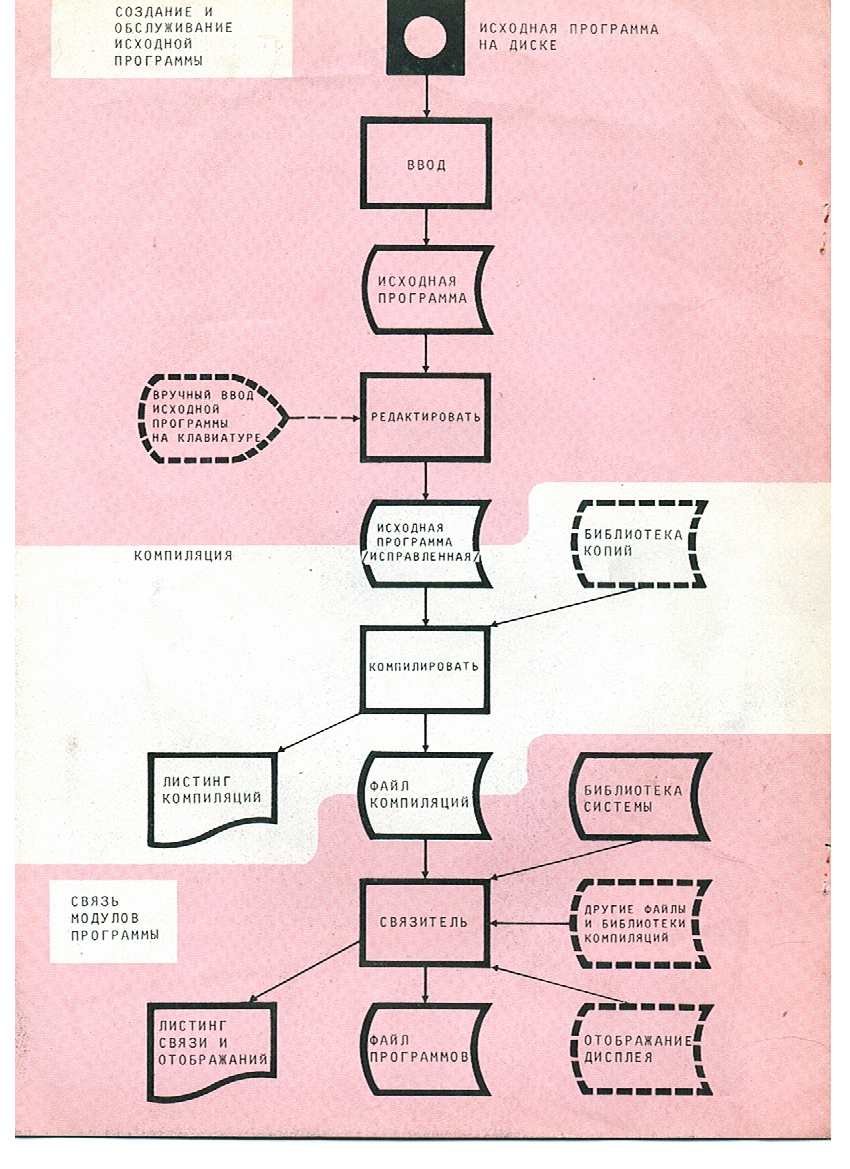 |
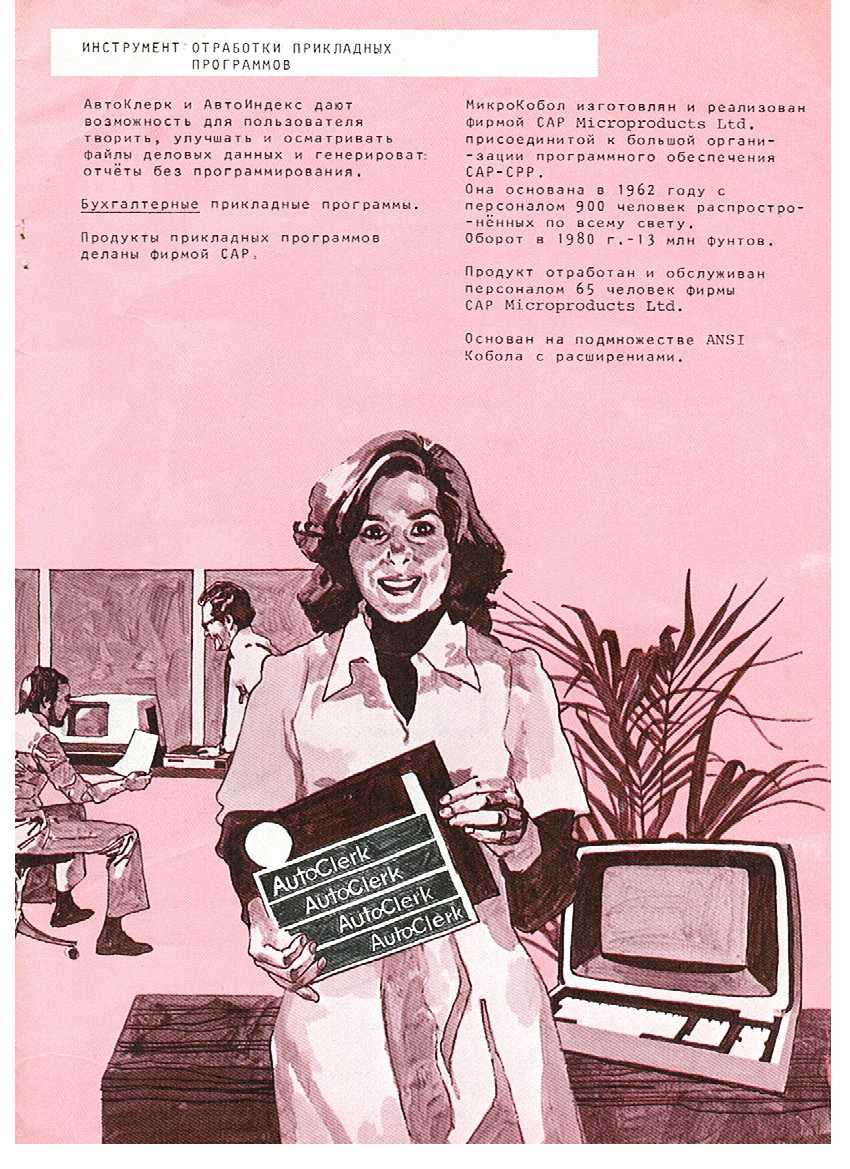 |
1997 phone list:
http://thedarts.eu/bos/phone1.pdf
However, recognising that CAP would always focus on mainframe software development for government, the Microproducts management team engineered a buy-out and in May 1981 the new organisation commenced trading as three linked companies - Microproducts Software Ltd, Microproducts Programming Ltd and Microproducts Training Ltd.
The new companies set up business at 87-89 Saffron Hill, London EC1 - not far from their previous location at CAP Ltd. Product development continued to be a major focus, but it was the emergence of a large and geographically widely-spread reseller network at this time which was critical to the organisation's future success. The bulk of the reseller channel recruited then is still with the company and much the same continuity can be observed in the user base.
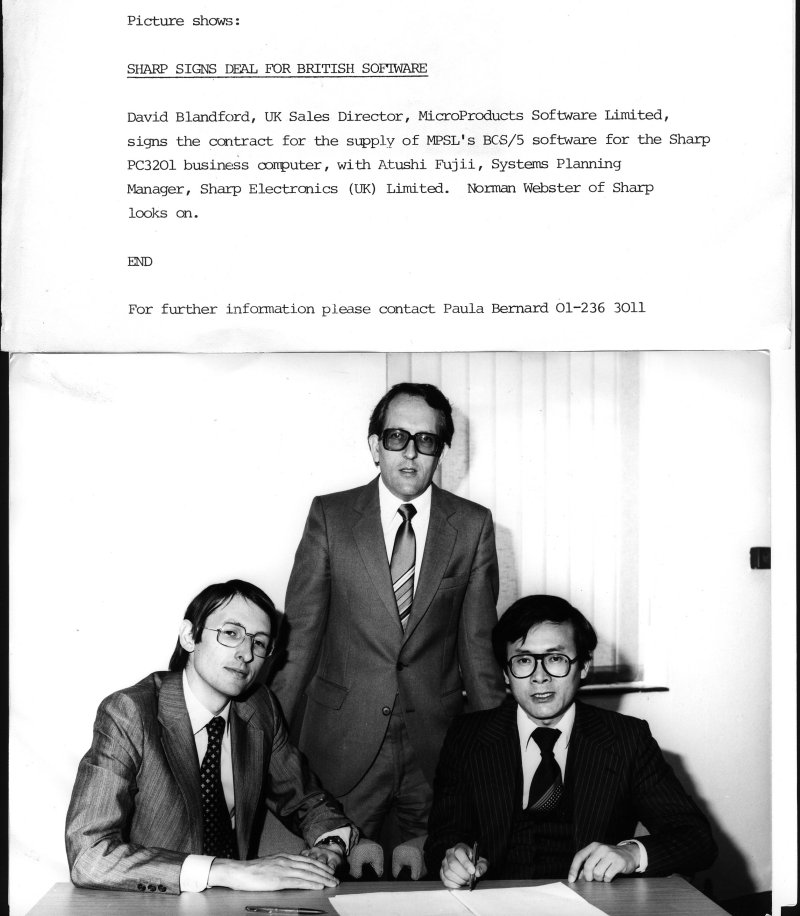
Sharp PC-3201
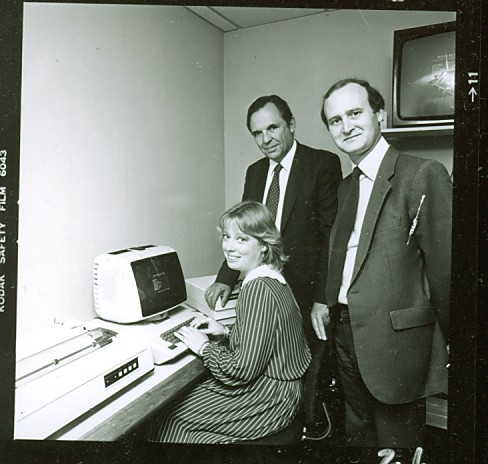
(Hilary Dyson, Robin Alistair Jacks, right)
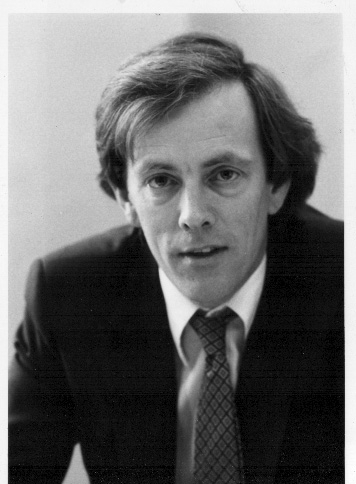
(John Evans made the move from CAP to MPSL)
In 1982 the company renamed itself BOS Software Ltd and a more commercial orientation continued to develop. As well as building the indirect (reseller) sales channel, the company won a number of significant direct contracts with government organisations such as the Home Office, Foreign & Commonwealth Office, Forestry Commission and the British Army - all of which are users to this day. The culmination of this was the Duke of Edinburgh's decision in 1984 to use what was then termed BOS software for his private office; the company retains the royal warrant to this day.
In 1986, BOS Software held the BOS User Show 22/23 October 1986, Kensington Rainbow Exhibition Centre. The official show guide was contained in a specially prepared issue of BOS World. The pages can be seen here.
By 1987 BOS Software Ltd was turning over in excess of £3 million per annum, and sought outside financial input to grow the business. Investors in Industry and Charterhouse both invested substantial sums with satisfactory results, but clearly to achieve critical mass in an industry which was rapidly maturing would require access to capital on a more permanent basis.
October 1987, Saffronrose implemented
BOS on LIP's Excalibur 68020. An article said:
"The BOS Software Ltd Business Operating System has moved upmarket following the effort by Barnet-based Saffronrose Ltd, which has implemented BOS to the Excalibur range from LIP (Equipment and Service) Ltd of Shipley, Yorkshire. Excalibur features a 32-bit Motorola 68020 chip running at 16.67MHz and LIP reckons it runs at 4 MIPS. It has 512Kb of (fast) static RAM expandable up to 8Mb and can support up to four disk drives with one floppy as standard. The supermicro, which has been available running Pick for some time, is said to provide a smooth growth path up into the minicomputer world. A 50Mb disk system with tape security back-up supporting 10 screens comes in at under £10,000, while the 380Mb version supporting 40 screens starts below £30,000. LIP began using the BOS/Excalibur combination in August to find a performance improvement in the order of 500%: it claims it has reduced daily security tape backups from nearly an hour to less than 15 minutes. Speaking at the launch was Professor Martin Healey from Cardiff University who warned against the government recommending Yankee rubbish like Unix and applauded £500,000-a-year Saffronrose for its commitment to BOS. Saffronrose believes BOS to be the best multi-user operating system, especially for first time users, because of its quick portability - it took an hour to port to Excalibur - and networking capabilities. A basic desk-top system with Motorola 68020 processor, 512Kb of RAM, two serial ports and one parallel port is priced at £3,790. Hardware maintenance costs 12% to 15% of the price depending on the location of the user".
In October 1987
BOS joined the floation queue. However these plans were thwarted by Black Monday
In November 1987
the BOS 2000 operating system was unveiled as BOS Software Ltd's all-singing, all-dancing marketing campaign took off in grand style at the Cafe Royal.
An article at the time said "Going all out to carve itself a serious niche in the operating systems marketplace, BOS has brought out a product it believes not only provides
portability across different machines but across different types of software too. It says this is achieved
with a new Application Executive, or Apex, feature.
PC-DOS, OS/2, Novell NetWare and DEC VMS all run under
BOS 2000 which is available in four versions: single-user SBOS 2000 which is single screen and single
tasking; MBOS 2000 for multi-user, -screen, tasking applications; concurrent CBOS 2000, single screen and
multi-tasking; and finally networked BOS/LAN 2000 for
single or multi-tasking, multi-screen computers linked
in a local area network.
The new operating system can run on a range of computers based around Intel's 8086, 80286 and 80386 processors; the Motorola 68000 family, and the DEC PDP-11, MicroVAX and VAX 8000. IBM PS/2s, Personals and compatibles are fully supported for multi-user and networking operations.
BOS reckons that although BOS 2000 is the host system, applications running under it won't be significantly slower.
In the 8-bit micro days when the original operating system was written developers had to work to strict limits and memory space was put to its best advantage.
According to the Saffron Hill, London-based company BOS 2000 typically requires less than 100Kb for the operating system and 64Kb for each active task, so more
screens and tasks can be supported on any one computer. Disk cacheing holds recently accessed data in memory to reduce disk traffic and increase performance and the RAM disk feature makes use of additional memory as a fast access disk alternative. BOS 2000 is said to make effective use of memory ranging from 256Kb to 16Mb and beyond. It also features BOS Communications which enables telecommunications applications such as automatic dialling, unattended operation and session logging to be developed. Terminal emulation, file transfer facilities and IBM 2780/3780 emulation are also available. The VMS version acting with BOS has been out in the field for the past four months.
Typically BOS 2000 would cost £200 for a single user, £690 for two to three screens and £990 for four to 12 screens. An upgrade from standard BOS costs £30.
The £3.8m-a-year company also has new look products to show off. Its business software packs including sales ledger, invoicing, sales order processing, stock control, spreadsheet and nominal ledger which has been completely re-written - now have multi-tasking, windowing and colour facilities with increased integration between modules.
BOS says it intends to develop links with companies that have expertise in NetWare and VMS and expects to make an announcement in the next two to three months. So with its newspaper advertising banners flying high, proudly proclaiming the fastest operating system comes from Saffron Hill not San Francisco, BOS Software is hoping the BOS 2000 range will see it well into the twenty-first century".
--ends--
At this point, the company attracted the interest of Misys plc, a computer services group with a growing reputation for acquiring high-tech companies, improving their financial management, encouraging technical synergy between group companies and using the cash thus generated to invest in product and growing the group by further acquisition.
On 3rd June 1988 BOS Software became part of the Misys group of companies.
Misys paid just over 2 million new shares to the 40 shareholders of BOS Group - directors, employees and three major institutions valuing the business software and operating system developer at £5.8m.
BOS shareholders ended up with 20% of the enlarged company after the transaction.
BOS, which had operating profit of £419,000 for the year to April 1987 on turnover of £3.8m, and unaudited operating profit of £550,000 in the 11 months to March 31 1988, operated as an autonomous subsidiary under its existing chairman Alistair Jacks, who also joined the board of Misys.
The same year saw the release of version 6.0 of the BOS applications, which offered a huge leap forward in terms of software functionality, presentation standards and 'connectivity' (the ability to run under different operating systems as well as on different hardware platforms). The product range was renamed BOS 2000 to reflect the change - so what was, for example, BOS/Sales Order Processing became BOS 2000 Sales Order Processing, while the BOS Operating System was renamed the Apex Presentation Manager.
Meanwhile, the open systems revolution continued apace, with suppliers deemed to be non-standard or proprietary meeting sales resistance in some (particularly government-related) markets. Accordingly, the company decided to move further away from the name 'BOS' by renaming the BOS 2000 applications 'Global 2000' in 1989. Later that year, the new identity was fixed when Misys reorganised its Open Systems division, of which BOS Software formed part. The applications development team from another group company, TIS Ltd, was added to the BOS business and the resulting conglomerate named 'TIS Software Ltd'.
In a bid to become the UK market leader in business software, the BOS Software Ltd arm of the Misys group launched a new operating system, Apex, which marked BOS's move into the Unix market. The launch of Apex meaned that BOS could offer Global 2000 applications software to users of all personal computer operating systems - PC-DOS, with or without Microsoft Windows, Unix, and DEC's VMS operating system for minicomputers. At the time the Global range had a user base of 15,000, but the introduction of Apex expanded that base.
BOS joined forces with Technology for Business Plc and Altos Computer Systems to sell a total business solution. The solution comprised of an Altos 5/386 Unix system that ran Global 2000 software, marketed through the London EC1-based Altos distributor Technology for Business, which had exclusive rights to the distribution of Apex on Altos 5/386. The three companies involved invested about £200,000 in this marketing initiative. The system was demonstrated at the Which Computer? Show where visitors were invited to see the complete range of Global 2000 modules, plus third and fourth generation programming tools, running under Apex on Altos machines
The next major development commenced almost immediately. The company saw a market opportunity for a high-end, Unix-based applications suite and tasked a number of group companies with developing the new product. With its many years experience of developing packaged software TIS Software Ltd took the leading role in this process, which culminated in the release in April 1991 of 'Strategix'.
As the Strategix project neared completion, the decision was made to exploit some of the technical spin-off by developing a 4GL-based successor to the well-established Global 2000 product. Global 3000 would aim at the middle ground - where the reseller channel is still pre-eminent - and provide an upgrade path for the enormous (25,000 plus worldwide) Global 2000 user base. The combination of the ultra-portable Global System Manager environment and modern look and feel with 4GL tailorability has turned out to be highly popular.
Newsletter from 1992:
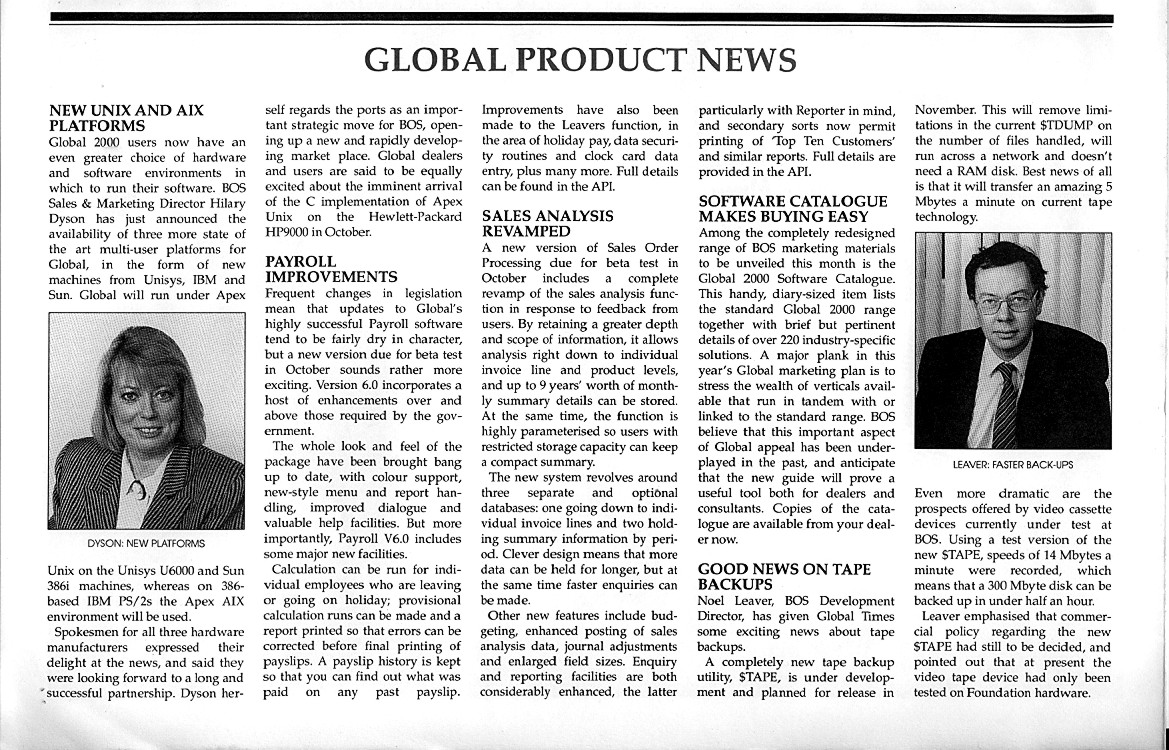
Meanwhile, Strategix quickly proved a success in its chosen markets. It was found, however, that in the higher reaches of the market customers insisted on dealing directly with the software authors. The decision was therefore reached to take the most successful Strategix reseller among the group companies, TEAM Systems Group Ltd, and merge it in with TIS Software as a direct sales arm for the Strategix product. The merger took place in 1993 and has been an unqualified success.
However, it was anticipated by all concerned that common marketing of two major product lines with very different names, neither of which related to the company name, would prove difficult. For this reason, soon after the merger in late 1993 TIS Software effectively split its sales and marketing operations into two distinct business units - Global Business Systems and Strategix Solutions. The two business units share offices in London EC1 and Bourne End, Buckinghamshire, together with common accounts and head office functions, but operate independently with regard to development, support, sales and marketing.
In March 1999, the directors of TIS Software engineered a management buy-out supported by venture capitalists Sand Aire Private Equity Ltd, and with the backing of the company's bankers. The company looks ahead to the new millennium as an independent vendor. It is anticipated that the freedom to re-invest in products and people will impact favourably on the company's success in its chosen markets.
In September 2006 TIS Software Ltd moved out of their City Offices in Farringdon Road and moved it's operations soley to Bourne End.
On Friday 14th October 2011, TIS Software Ltd were acquired by Kerridge Commercial Systems.
The Bourne End office was closed on the 23rd March 2020 due to the Covid-19 outbreak and "lockdown".
On Monday 13th July 2020, we were informed that Kerridge will close the Bourne End office for good, this happened in October 2020.
Global System Manager
Global System Manager is an environment for many business applications, which provides a sophisticated screen interface, print spooling and concurrent running of several programs on one screen.
The wide range of Global application modules interface to Global System Manager. Global System Manager always interfaces with a host operating system. This operating system may be Unix, BOS, MS-DOS, Novell or Windows.
Global System Manager displays a menu on your screen as soon as it is initiated. The menu lists the application programs installed on the system. You can select a particular application, such as Global 3000 General Ledger, by merely keying the appropriate number.
When you select an application from the menu, Global System Manager picks up any special unit assignments necessary from the menu handler. These assignments inform Global System Manager where on disk the application program and its associated data, can be found, and sometimes which printer to use, or which diskette drive to use for taking security copies of data.
Global System Manager then loads the program into memory and passes control to it. From then on it will appear to the operator that the application is in complete control of the computer. However, whenever it needs to access a peripheral, the application program will send a message to Global System Manager of the form 'read next data record from unit SLD' or 'print the following characters to unit $PR'. Global System Manager then translates the unit assignments SLD or $PR into the appropriate physical addresses of the data unit or printer, and does the actual work of reading from the disk or writing to the printer.
Global System Manager also performs the vital task of file locking and record locking for applications. In multi-user or networking environments, a number of different users need to have simultaneous access to the same file. A mechanism is required which 'locks' a particular area of a file (a record) when one user is updating the data held there, but which leaves the rest of the file available for inspection or updating by other users. Similarly, there must be a facility to lock a whole file for certain processes (e.g. backup procedures) where simultaneous updating would be disastrous.
Global System Manager provides two different kinds of utilities: System commands and system requests. You run a system command by keying its name ($F, $V etc.) to the menu selection prompt (“Please select a function”) or the READY prompt. The program requested is then loaded into the current partition's memory bank and executed. Typical system commands enable you to copy files, send messages to other users, or find out what units are attached to your computer.
System requests differ from system commands in that you can invoke them at any point when running a Global application, from a menu or the GSM Pn READY: prompt, from the middle of an application program or system command, or even from within another system request! You press the SYSREQ key followed by a number or letter, and Global System Manager performs the action required. Typical system requests enable you to change from one partition to another, invoke the Global System Manager screen calculator, invoke the Help facility, or to shift between different display windows in the same concurrent partition.
Global 2000
![]()
Global 2000 (aka “BOS” or “BOS 2000”) is a well-established business system which was first released in 1981, and which has been continually upgraded and developed since then. Global 2000 features complete suites of accounts, distribution and office automation modules, with links to some 200 vertical market modules. Global 2000 runs on a wide range of hardware and operating systems, and is sold and supported by an international reseller network of 150 companies in more than 20 countries.
It is written in BOS/MicroCobol & is text based:
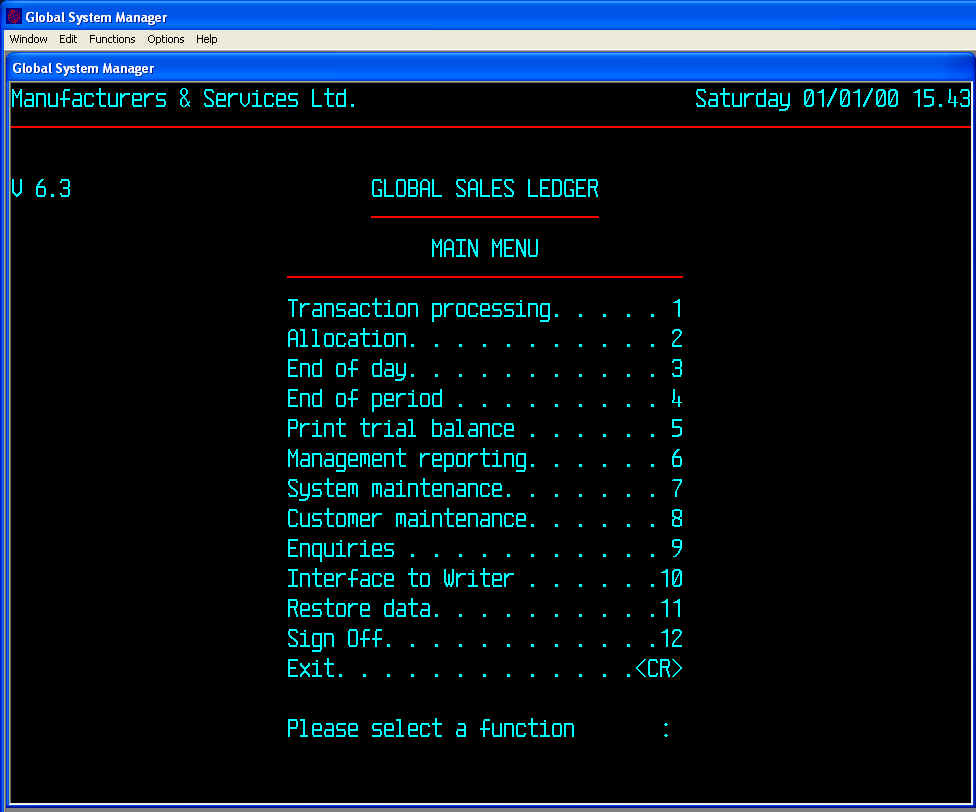
CASH MANAGER Multi-company, multi-currency cash book control, with integral 6 month spreadsheet for cash flow planning. Can be used standalone, as a complete accounting system for the small company, or integrated with Nominal Ledger.
FINDER Highly flexible database/record keeping software. Handles any number of separate databases, each with up to 65,000 records. User definable record structures and reporting.
FIXED ASSETS Fixed assets register with automatic calculation of depreciation on an asset by asset and period by period basis. Handles partly depreciated assets, asset extensions and non-capitalised assets. Optional posting to Nominal Ledger.
INVOICING Multi-currency invoicing and credit note production, plus sales analysis by customer, product, territory or salesperson. Links with Sales Ledger for customer details, and optionally with Stock Control for product data.
JOB COSTING For costing and monitoring the progress of contract work. Links to Payroll for posting of clock card data to individual jobs, Purchase Ledger for allocating costs on an invoice by invoice basis, and Stock Control for recording materials used. Other costs can be directly entered. Optional link to Sales Ledger for customer billing.
NOMINAL LEDGER Hub of the Global 2000 accounting suite - multi-company and multi-currency handling plus powerful facilities for defining your own financial statements. Accepts postings from most other Global 2000 modules, including Sales and Purchase ledgers, Payroll, Fixed Assets and Cash Manager.
PURCHASE LEDGER Automates purchasing from any number of suppliers - from invoice logging through to cheque printing - plus historical analysis by cost centre or supplier. Interface to BACS for payments and optional posting to Nominal Ledger.
PURCHASE ORDER MANAGER Enhances Purchase Ledger with the facility to place purchase orders with suppliers, and to monitor the progress of orders, deliveries and invoices. When integrated with Stock Control, automatically updates stock figures when delivery is confirmed.
SALES LEDGER The complete sales office tool - multi-currency, balance forward or open item customer accounts, aged debtors analysis. Links with SOP or Invoicing for customer billing, and with Stock Control for stock updating. Powerful credit control facilities, and optional posting to Nominal Ledger.
SALES ORDER PROCESSING Multi-currency order processing software. Handles forward orders, repeating orders and quotations for a wide range of product types, as well as straightforward invoices and credit notes. Links with Sales Ledger for customer details, and optionally to Stock Control for product pricing and stock level adjustment. Full sales analysis functions.
STOCK CONTROL Automated stock handling software. Multiple warehouses, multiple prices per product plus automatic re-pricing facility. Interfaces to SOP, Invoicing and Purchase Order Manager for updating stock balances and statistics as sales or purchase orders are processed.
Global 3000
(Screenshot showing Global 3000 6.0 running using the GX thin client)
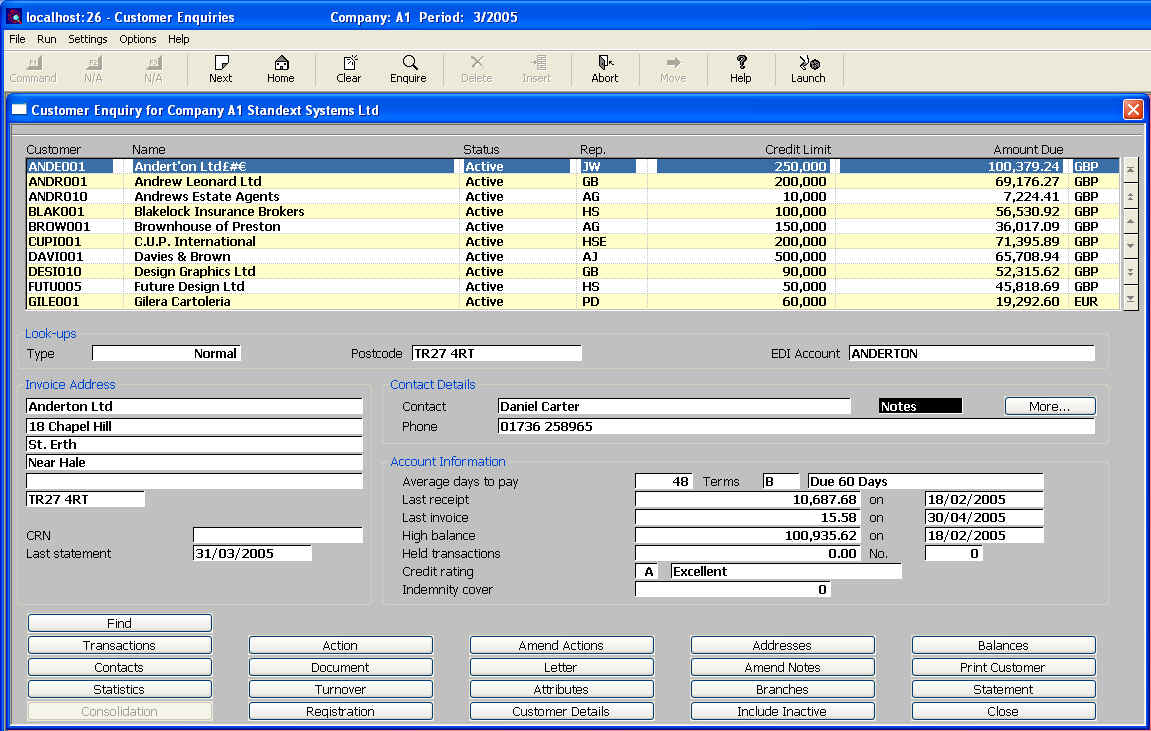
Global 3000, written in ** Speedbase, comprises highly functional and flexible ledgers, distribution, manufacturing and industry-specific modules running on Windows & Unix. Global 3000 6.0 offers a GUI interface via the GX thin client, plus the unique productivity benefit of multi-tasking on every screen so each user can run up to 9 concurrent tasks.
Global 3000 client/server options enable system overheads to be spread more evenly. On Unix, Global runs in thin client mode, with applications and data residing on the server and client PCs handling screen I/O. On Windows, both fat and thin clients are supported. Global 3000 6.0 only runs using the GX thin client when connected to a fat client.
Global 3000 offers seamless integration with industry standard office applications - from cut and pasting of data on the Windows desktop through to file export to word processors and spreadsheets, plus the further option to use SQL (Microsoft & Pervasive) database structures and/or ODBC connectivity for enhanced two-way integration with third party products.
Global 3000 ledgers offer unlimited profit centres and complete transaction history retention. The distribution suite offers batch and serial number tracking for BS5750 compliance, back to back ordering, sophisticated pricing mechanisms and user-definable unit handling. Manufacturing modules handle bills of material and process routes of any level of complexity, and simple production orders or full works order processing.
Global 3000 accounting goes way beyond statutory reporting. That's because business today demands multi-dimensional analysis of revenues, costs, cash flow and assets, down to any level of detail. Global 3000 offers full multi-company and multi-currency processing, with unlimited profit centres and the option to retain as much historical data as you require. The combination of extensive built-in analysis functions and easy data exchange with industry standard tools makes for a uniquely powerful management reporting system.
** The Speedbase Development Language is a high level
compiled programming language which allows extremely rapid development of
commercial data processing systems. It consists of a number of very high level
constructs, which are used to specify interaction between stored data and the
user. To make maximum use of the available facilities, this data will normally
be stored in a Speedbase database, which provides full relational control and
retrieval facilities.
Speedbase has dramatically expanded the functionality of
traditional development languages such as Cobol, while maintaining upward
compatibility. Speedbase encompasses the functionality of both Assembler and
Cobol, and statements from these language may be interspersed with Speedbase
high level facilities.
As a programming language, Speedbase has been aimed at the data processing
professional and is not regarded as an end-user product. It has been designed to
facilitate rapid development of complex business systems, the design of which
would be far beyond the capabilities of most computer end-users. Speedbase may,
of course, be used to develop relatively simple applications, but its main
strength lies in its ability to control and integrate large volumes of diverse
business data.
This data control function is performed by a run-time environment known as the
Speedbase Presentation Manager, a network structured dbms integrated with a
sophisticated windowing system which has been designed and optimised
specifically for use on mini and microcomputer systems. All frames written using
the Speedbase Development Language are automatically interfaced to the Speedbase
Presentation Manager which is present whenever Speedbase frames are executed.
Speedbase provides the following capabilities:
High level window constructs are used to define operator dialogue and provide a
powerful, consistent and simple end-user interface. This includes features such
as window overlays, POP-ups, dynamic function key facilities, split-screen
scrolling, partially scrolled records and automatic window sequencing.
Automatic enquiry mode facilities allow data records to be retrieved by any of
up to sixteen indexes for each record type. These facilities operate within all
application frames using the database.
High level Print Format construct defines report layouts. This construct defines
the print layout and automatically generates the MOVE statements required to
assemble the print line. Spooling, page throw conditions and printing restarts
are also handled automatically.
Instant access by each frame to up to four complete databases, each containing
up to 36 separate record types (files) and up to 90 indexes. Database open and
close procedures are automatically performed by Speedbase.
Fast database accessing verbs including READ, FETCH and GET. Retrieval of data
records may take place either directly or via each of up to 16 indexes
associated with each record type. FETCH FIRST, LAST, NEXT, and PRIOR are
supported, allowing records to be retrieved in both ascending and descending
index order.
Speedbase supports three generations of language constructs in a single
development environment. A single source frame can contain assembler
instructions (2GL), Cobol instructions (3GL), and fourth generation (4GL)
constructs such as windows.
Fast, single pass compiler containing an integral linkage editor, which directly
generates executable frames.
Full Data Division implementation including Cobol FD constructs to allow
interfacing to traditional indexed and relative sequential files. BASED variable
declarations are also supported for system programming applications.
Frames written using Speedbase are automatically multi-user, with record level locking. Speedbase applications may be implemented on either micro or mini computers providing simultaneous access to more than a hundred screens. Over sixty different computer hardware systems are currently supported, and both source and object frames and user data are 100% compatible across this entire range;
Speedbase supports local area network (LAN) implementations, and allows databases to be dispersed across networks with up to twenty-six file servers, supporting hundreds of screens. Record level locking is supported across the entire network, thus allowing LAN implementations without frame modifications;
Speedbase supports the storage of its database in a series of C-ISAM files in a Unix file structure. When stored in this form the database may be accessed by other Unix application programs written in languages such as Informix. A program produced by the Speedbase Development System may access databases in either the usual Global System Manager (GSM) format or in the Unix format, or both.
Speedbase application systems consist of programs known as frames. Each frame is an individually loadable object program, which will perform a particular task within the application, such as data entry and maintenance of a particular record type, or the production of a report. Each frame will usually require access to one or more Speedbase databases, and these are normally opened by the Speedbase menu program before execution.
Each Speedbase frame will usually consist of one or more windows in which data will be presented to, and accepted from the operator. Windows are used to present a particular view of the data stored within a Speedbase database, and provide enquiry, data-entry and maintenance facilities for this data. Complex frames are simply built up from a series of these windows, each window performing some aspect of the overall task.
For example, an order entry frame might consist of three windows. The first window would be used to select a particular customer, the second would allow data-entry of order header details such as delivery address, and the third window would allow entry of individual order detail lines. Each window would normally also provide enquiry and update facilities. More complex tasks can then be built up from even longer series of windows.
Windows are specified by using non-procedural code, and quite complex applications can be produced in this way. It is quite usual, however, to code procedural instructions to perform additional specialised processing, such as application specific validation routines. Entry-points are provided to allow this during many processing stages. It is even possible for procedural code entirely to "take over" control of the frame.
When procedural logic is required, it may be written using traditional Cobol statements. Speedbase also provides assembler statements, which may be used for highly technical programming tasks. All of these statements can be coded within the same source frame, and this gives the programmer an extremely flexible development environment.
Owing to the power of the Speedbase high level facilities, frames tend to be small. A typical Speedbase frame would take up less than two pages of code. A source program file therefore normally contains many individual frames, which are compiled together. The Speedbase compiler produces a single executable object file for each frame in the source program. These object frames can then be executed after any required databases have been opened.
The Speedbase compiler contains an integral linkage editor, which Is used to link any required system routines into the object frames. It is usual, however, for these routines to reside in a service module which is automatically loaded when the frame is executed.
The service module contains most of the system routines normally used by frames, such as the routines used to perform database I/O and screen manipulation. A large fraction of the service module consists of a series of page-able monitor overlays which although permanently resident are outside the user memory space.
Most Speedbase frames will therefore easily fit into available memory. Particularly large frames can, however, be segmented using a feature called dependent frames. Dependent frames can automatically access all data items and I/O channels resident in higher levels of the overlay structure, and need only a single statement to be specified. This feature allows complex overlay structures to be established during the course of development, and needs little prior planning or design.
Speedbase also provides high-level facilities for the production of reports. Using the PF construct, complex reports can be produced with very little effort. The PF construct generates print-lines automatically, handles page throws, provides for spooling, and takes care of a variety of error conditions. This construct will normally be used for the development of more complicated reports, more straightforward listings being produced by Speedquery, the Speedbase Query System.
Speedquery provides a generalised screen-driven method to access the information stored on a Speedbase database. Speedquery allows end-users to view data in quite sophisticated ways, and to produce either on-line or printed output. This same facility can also be used by professional developers to produce pre-formatted enquiry and report frames.
The most striking feature of Speedbase applications is their consistent "look and feel". All frames operate using the same powerful conventions, and provide the same operator facilities. This means that once an operator has learned to use a single Speedbase frame, little effort is needed to understand the use of the rest of the application, or any other Speedbase application.
Merchandise
Back in the day BOS Software had a range of merchandise ranging from
cups, pens, t-shirts, umbrellas, bags, posters, coasters, flags etc. Although
the umbrellas & bags only appeared when Global 3000 was released.
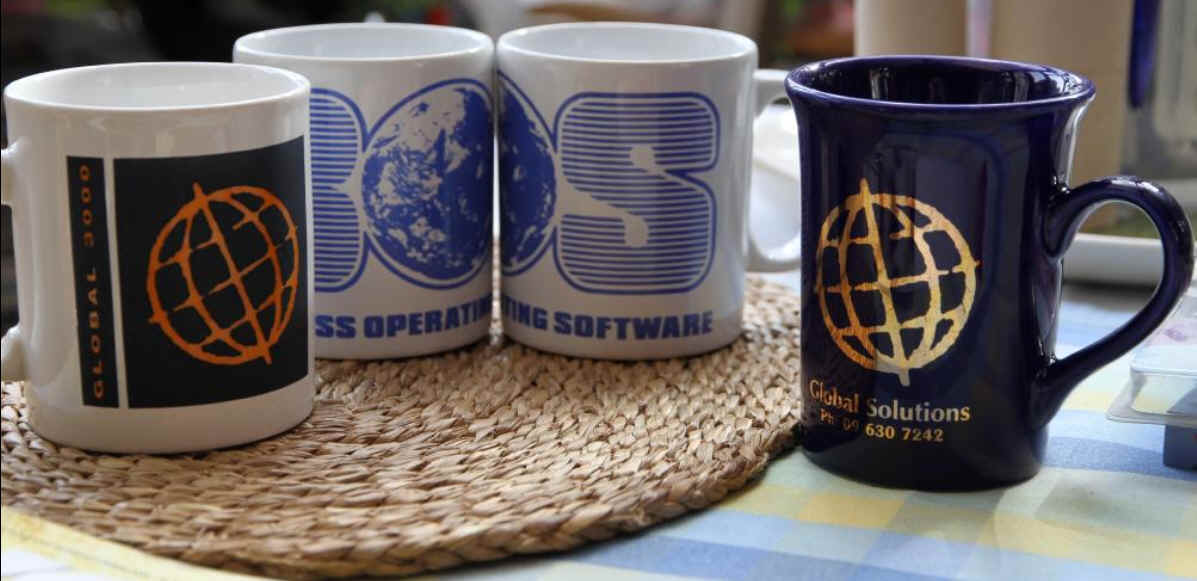
The Business Operating Software cups (middle) are circa 1985. The Global 3000 cup is from the 1990's as is the Global Solutions (New Zealand) cup.
Although not strictly merchandise, the software came with
manuals in nice quality ring binders, either sporting BOS Software (white ring
binder) or Global 3000 (black ring binder), diskette boxes & sleeves.
The posters (like the one at the top of this page) were spotted at various
London Underground tube stations in the 1980's.
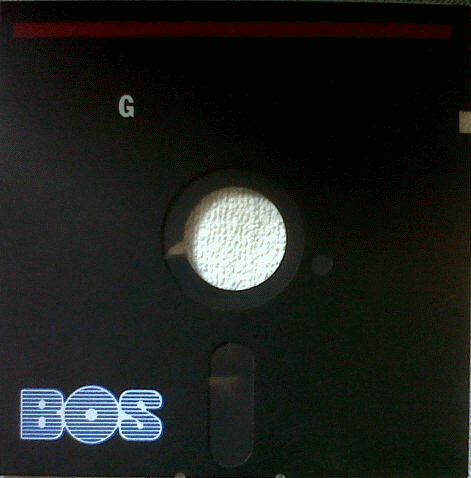
G1A, 5.25" diskette from back in the day. List
of other formats.
Games
A list of games here.
Last updated 31 October 2020